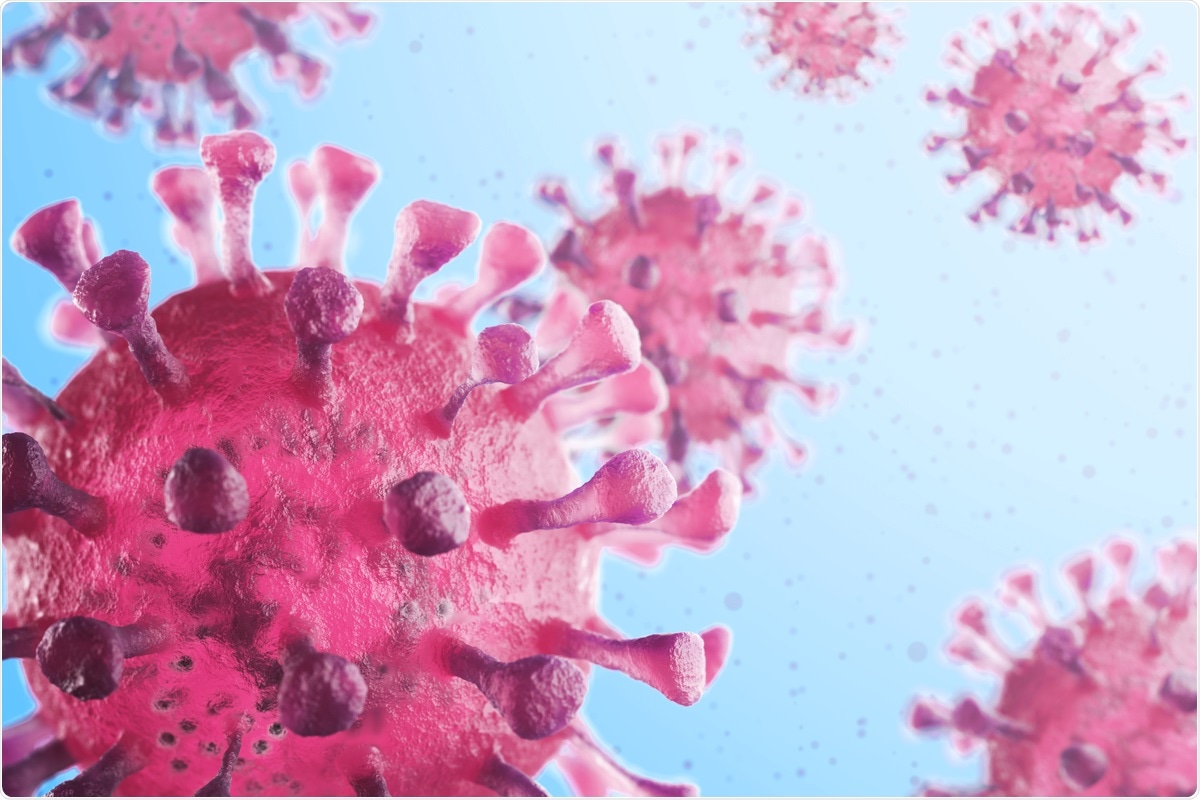Severe acute respiratory syndrome coronavirus 2 (SARS-CoV-2) is the causal agent of the coronavirus disease 2019 (COVID-19) pandemic. This virus causes mild to severe disease, and to date, it has claimed more than 4.8 million lives worldwide. In the case of severe disease, scientists revealed that over-reaction of the immune system leads to a cytokine storm. Excessive cytokine levels correlate with mortality.
 Study: ZBP1 induces inflammatory signaling via RIPK3 and promotes SARS-CoV-2-induced cytokine expression. Image Credit: creativeneko/ Shutterstock
Study: ZBP1 induces inflammatory signaling via RIPK3 and promotes SARS-CoV-2-induced cytokine expression. Image Credit: creativeneko/ Shutterstock
Background
Researchers stated that antiviral innate immune responses cause inflammation and cell death. However, deregulated immune response contributes to pathological inflammatory conditions. Previous studies have identified receptor-interacting protein (RIP) kinases (RIPKs) as the main regulators of cell death and inflammatory signaling pathways. These receptors are engaged downstream of immune receptors and influence host immune defenses against viruses and bacteria.
Z-DNA-binding protein 1 (ZBP1) is a cytosolic nucleic acid sensor and an interferon-induced pattern recognition receptor (PRR) which is extremely important for antiviral immune responses. Previous studies have reported that activated ZBP1 employs RIPK3 and RIPK1 to perform programmed cell death, including apoptosis, pyroptosis, necroptosis, or a mixture of them. The specific function depends on the cell type and caspase activity.
RIPK3 causes necroptosis via phosphorylation of mixed lineage kinase domain-like (MLKL) protein, resulting in oligomerization and forming pores in the cell membrane. RIPK3 contains a RIP Homotypic Interaction Motif (RHIM), which helps to employ other RHIM-containing proteins, such as RIPK1, the Toll-like receptor (TLR) adaptor, TIR-domain-containing adapter-inducing interferon-β (TRIF), and ZBP1.
In addition to necroptosis, RIPK3 promotes inflammatory signaling during tumor necrosis factor (TNF) – and TLR – induced necroptosis downstream of ZBP1. However, the mechanism of RIPK3-mediated inflammatory signaling remains unclear.
A new study
A new study published on the bioRxiv* preprint server reported that the ZBP1-induced inflammatory signaling pathway is dependent on ubiquitination and RIPK3’s scaffolding ability, independent of cell death.
This study further revealed that inhibition of caspase-8 activity exposes a RIPK3 kinase activity-mediated inflammatory signaling pathway similar to the pathway triggered by TNF when cIAPs and caspase-8 are inhibited.
Importantly, the authors of this study documented evidence to show that ZBP1 influences the generation of cytokines and chemokines during SARS-CoV-2 infection. The main findings of this study are discussed below under the following categories.
RIPK3 and inflammatory signaling
The current study has shown that RIPK3 is a true inflammatory mediator. Scientists concluded by revealing that it is an essential adaptor protein in ZBP1-dependent inflammatory signaling in human cells. The study identified RIPK1 and RIPK3 as scaffolding kinases that promote the ZBP1-triggered inflammatory signaling pathway, independent of cell death.
Researchers found that ZBP1-RIPK3-RIPK1 inflammatory signaling is dependent on K63-Ub, M1-Ub, Ub ligases cIAPs, and LUBAC. However, it is not dependent on the kinase activity of RIPK1 and RIPK3. In the study of the ZBP1 signaling complex, researchers relied on Dox-induced overexpression of ZBP1. This is because it prevents time-consuming experiments associated with the assembly of the signaling complex and ubiquitination dynamics of complex components after ligand-binding.
Although more research is required to determine if RIPK3 kinase activity-dependent signaling leads to inflammatory gene activation, the current study has indicated the role of RIPK3 in ZBP1 inflammatory signaling as a scaffolding kinase. Also, the kinase activity-dependent pathway is functional when caspase-8 activity is antagonized during infection by viruses encoding caspase inhibitors.
However, it remains unclear how caspase-8 regulates RIPK3 kinase activity-dependent signaling. Still, this study has shown that caspase-8 activity inhibits kinase-activated RIPK3, which would otherwise trigger inflammatory signaling in a kinase activity-dependent manner.
ZBP1-mediated inflammatory signaling and cell death
Researchers have successfully expanded the understanding of ZBP1’s function by uncovering its role in SARS-CoV-2-induced chemokine and cytokine expression. ZBP1, in a ligand binding-dependent manner, can trigger RIPK3-mediated inflammatory signaling at a poorer expression threshold which may promote cell death.
The authors of this study revealed that ZBP1 triggers ubiquitin-dependent NF-κB signaling as the first line of defense to recruit innate immune cells such as neutrophils and monocytes. Also, when ZBP1 expression is highly induced by interferons, cell death occurs.
ZBP1 and SARS-CoV-2
The current study reveals that ZBP1 is upregulated by COVID-19 infection. This expression is correlated with the expression of pro-inflammatory chemokines and cytokines that include CXCL10/IP-10 and IL-6. In severely infected COVID-19 patients, scientists found that IL-6 and CXCL10 are upregulated as a part of cytokine storm, and importantly, the levels of IL-6 correlate with mortality.
The study also indicates that ZBP1-mediated inflammatory signaling may influence an unbalanced immune response in COVID-19 patients, which may cause reduced antiviral signaling and enhanced inflammatory levels.
*Important Notice
bioRxiv publishes preliminary scientific reports that are not peer-reviewed and, therefore, should not be regarded as conclusive, guide clinical practice/health-related behavior, or treated as established information.
- Peng, R. et al. (2021) "ZBP1 induces inflammatory signaling via RIPK3 and promotes SARS-CoV-2-induced cytokine expression". bioRxiv. doi: 10.1101/2021.10.01.462460.
Posted in: Medical Science News | Medical Research News | Disease/Infection News
Tags: Apoptosis, Bacteria, Cell, Cell Death, Cell Membrane, Chemokine, Chemokines, Coronavirus, Coronavirus Disease COVID-19, CXCL10, Cytokine, Cytokines, DNA, Gene, Immune Response, Immune System, Inflammation, Interferon, Interferons, Kinase, Ligand, Membrane, Mortality, Necroptosis, Necrosis, Neutrophils, Nucleic Acid, Pandemic, Phosphorylation, Programmed Cell Death, Protein, Receptor, Research, Respiratory, SARS, SARS-CoV-2, Severe Acute Respiratory, Severe Acute Respiratory Syndrome, Signaling Pathway, Syndrome, Tumor, Tumor Necrosis Factor, Ubiquitin, Virus

Written by
Dr. Priyom Bose
Priyom holds a Ph.D. in Plant Biology and Biotechnology from the University of Madras, India. She is an active researcher and an experienced science writer. Priyom has also co-authored several original research articles that have been published in reputed peer-reviewed journals. She is also an avid reader and an amateur photographer.
Source: Read Full Article
